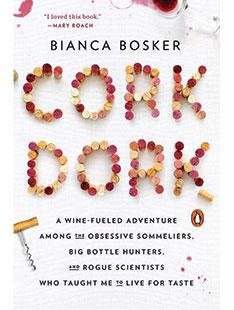
“If you’ve ever wondered what all the fuss is about wine, whether there’s really a discernible difference between a $20 and $200 bottle, or what would happen if you pushed your senses to their limits ... Well then, I have some people I’d like you to meet.” With that, Bianca Bosker ’08 introduces us to Cork Dork (Penguin), an account of her quest to demystify that most intimidating of tipples.
Don’t expect a guide to wine regions. Think Hunter S. Thompson with a midday hangover. In the restaurant business, cork dorks are serious oenophiles. As Bosker discovers their world, readers learn why sommeliers rhapsodize about a wine’s leather notes, how restaurants judge you, and how to avoid hefty wine-list markups.
Bosker is not one to explore an interest halfheartedly. Her first book, on copycat architecture in China, was based on her senior thesis. She co-founded The Huffington Post’s tech section, leaving only when she became enthralled by sommelier competitions — or as she puts it, “the Westminster Dog Show, with booze.”

A humbling start in a wine cellar sets the tone. Bosker is self-deprecating as she flubs cork-pulling, learns to identify mystery wines, and memorizes miscellany. “I haven’t made that many flashcards since I was studying Chinese at Princeton!” she tells PAW.
With a journalist’s skepticism, Bosker goes beyond sommeliers’ more superstitious practices and into sensory-science labs. The book’s surprising take-home message is that humans aren’t bad sniffers, and that it’s possible to enhance your senses of smell and taste with training.
Cork Dork also introduces the contrasting realms of the wine universe. The first is the highfalutin community inhabited by hipster sommeliers and wealthy wine collectors. At a series of bacchanals known as La Paulée, they guzzle legendary, thousand-dollar bottles the way fraternity pledges chug cheap beer. “La Paulée is the kind of thing that starts revolutions in countries,” says one wry observer in the book.
The second realm, often absent in wine writing, is the mass market. Here we meet a pragmatic restaurant worker for whom sommelier status means a steady job. Also in this realm are companies that employ additives to match wine to consumer tastes. Factories produce millions of bottles each year, though you’d never know it from the mom-and-pop vineyards in their marketing copy.
“I wanted to portray the wine world as it is, not as marketers and critics want it to be,” Bosker explains. By the end of the book, she is spreading the gospel of wine, warts and all. Her grueling training has made her a fine ambassador. Maybe someday, she’ll also be a change agent. She’s starting on Instagram. In a series of posts with the hashtag #pairdevil, she teaches followers how to pair wines with everyday foods like mac and cheese. It’s an attempt to strip wine of its stereotypical snootiness. “The wine world needs to be more inclusive,” she contends. Even a cheap wine that’s pooh-poohed by poo-bahs, she adds, “is a great starting point that can lead you to better wine and new experiences.”











No responses yet